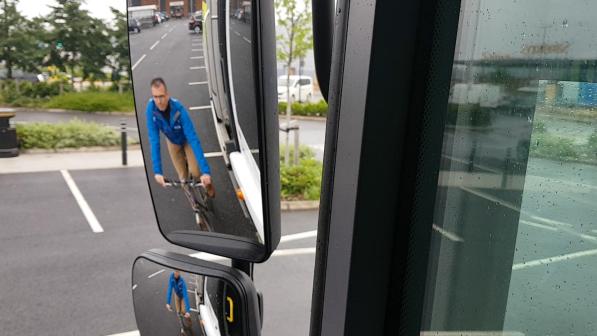Goods vehicles (lorries, HGVs, vans etc)
By Cherry

HGVs pose a disproportionate threat to cyclists
Headline message
- Although lorries are involved in relatively few collisions with cyclists, those that do occur are disproportionately likely to prove fatal.
- National and local government should take steps to regulate the use of lorries in areas that are busy with cyclists and pedestrians. Exemptions should be made only for specific journeys that clearly cannot be made in other ways or at other times, and should require the use of safe lorry designs, fleets and drivers.
- National and local government, lorry manufacturers and operators should collaborate to promote safe lorry designs and equipment, especially ‘direct vision’ cabs, which enable drivers to see what is around them as easily as bus drivers can.
- Enforcement processes should be strengthened to take unsafe drivers and operators off the roads, targeting the least compliant.
Policy key facts
- Heavy goods vehicles (HGVs) account for only around 3.6% of non-motorway motor traffic mileage on British roads, yet are involved in around 17.5% of cyclist fatalities. HGVs were also involved in almost 14% of pedestrian fatalities, so pose a serious threat to them too.
- HGVs on average account for around 2% of urban and 5% of rural motor traffic, yet are involved in almost a quarter of cyclist urban fatalities and just over 12% of cyclist rural fatalities.
- HGVs pose a very significant risk to cyclists in London. In 2015, they were involved in 78% of cyclist fatalities there, although they made up less than 4% of miles driven.
- Left-turning lorries are a major hazard. In 2015, thirteen cyclists in London were killed or seriously injured when a goods vehicle over 3.5t turned left across their path.
- Cyclists’ collisions with HGVs are far more likely to prove fatal than those involving cars: the cyclist is killed in about a fifth of serious injury cyclist/HGV collisions. This figure is around 2% for cyclists/cars.
Cycling UK view
- Lorries pose a disproportionate threat to cyclists.
- The most important measure is to eliminate the source of lorry danger in areas where people cycle or want to cycle, principally by regulating HGV use on urban roads when they are likely to be at their busiest with cyclists and pedestrians.
- Exemptions to the rules should apply only for specific journeys that clearly cannot be made in other ways or at other times, and should require lorries and their drivers and operators to conform to strict safety standards that maximise the safety of pedestrians and cyclists.
- To help reduce the demand for lorry movements in urban areas:
- loads from the largest lorries should be transferred to smaller vehicles, e.g. through transhipment depots on the edges of towns/cities;
- as much freight movement as possible should be shifted to rail and/or waterborne transport; and, where practical, to cargo cycles;
- councils and operators should work together on safe lorry routing strategies.
- CLoCS (Construction Logistics and Community Safety standard) should be adopted as a national standard for safer lorry equipment, driver training and fleet management. Local authorities should also make it a condition of planning permission, or section 106 agreements.
- Designing ‘direct vision’ into lorry cabs is one of the most effective ways of protecting cyclists and pedestrians on the outside. The Government should therefore introduce a national ‘direct vision standard’, modelled on the scheme being introduced for the capital by the Mayor of London.
- Other safety features that may be of benefit are mirrors, cameras, sensors, sideguards, intelligent speed adaptation and warning stickers.
- For lorry drivers, cycle awareness and practical cycle training should become a fully integrated and compulsory element of the professional training/qualifying process.
- For cyclists, training on how to interact with goods vehicles as safely as possible is beneficial. Publicity campaigns and educational events for drivers and cyclists alike also help highlight the hazards and how to avoid them.
- Cycling UK opposes moves to introduce longer and/or heavier lorries, unless they are strictly confined to motorways.
- All the responsible agencies (e.g. police, DVSA, local authorities and the Health and Safety Executive), should promote and enforce safe driving and vehicle standards for lorries. The Government should set up a national scheme to promote collaboration between these agencies, based on the model of TfL’s London Freight Enforcement Partnership.
- Traffic Commissioners should use their powers to act against irresponsible operators and drivers, and be assured of the resources to do so.
- Individual haulage companies and the associations that represent them should develop, publish, maintain and monitor strategies, action plans and fleet management practices that minimise the risks goods vehicles pose to cyclists. Where appropriate, these should be produced jointly with local authorities and enforcement agencies and have regard to the advice and guidance provided by groups representing vulnerable road users.
- Procurement policies, especially from public authorities, should stipulate that the supply and delivery of goods and services takes vulnerable road users’ safety into account; and that the operators comply with set, high standards (e.g. CLoCS for construction-related activities, or the equivalent for other operations such as waste disposal).
- To make it easier to check that haulage companies are reputable, their Operator Compliance Risk Scores (OCRS) should be made public.
- Cyclists benefit from road layouts and street furniture (e.g. ‘Trixi’ mirrors) that facilitate safe interaction between them and lorries.
- Research into the efficacy of all the above measures needs to be done, with the DfT, TfL, other local authorities and operators all collaborating EU-wide, as required. This should result in clear, consistent guidance for all operators and authorities.
2016-10-31 00:00:00 Europe/London
Campaigns policy public affairs
Safe roads traffic offences and the law
Road justice and traffic offences
Road safety
Safer vehicles
Action on lorries

